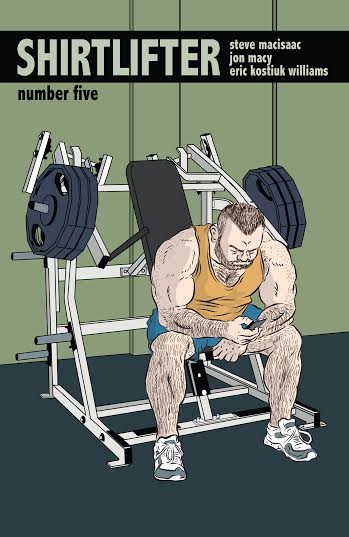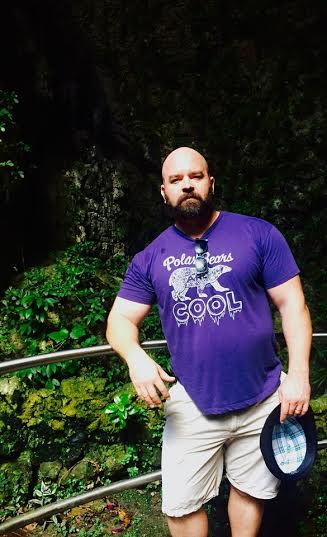What an exciting accomplishment it is to combine the forces of so many talented people in the LGBT comic business and create a special, one of a kind book to display just how amazing the people, stories and backgrounds are of each? That is what is happening this month with the launch of an amazing new Kickstarter campaign for a book called “Hard To Swallow”, a gay erotic comics anthology created by “No Straight Lines” Justin Hall and “Feral And The Ghostskaters” Dave Davenport. The campaign for this book to be released is going on now until March 1st, and for anyone in the LGBT community, this is something that you should really get involved in to help the art world and for these great people to showcase their work.
[Read more…] about Justin Hall & Dave Davenport’s “Hard To Swallow”- Get Involved
steve macisaac
Get To Know The Creative & Intelligent Steve MacIsaac
With the excitement of NYC Comic Con coming up very shortly, many comic book loving aficionado’s are bracing for what will hopefully be an epic weekend of seeing the creative art of thousands upon thousands of illustrators, artists and so much more. Something that will hopefully get some representation there is the awesome LGBT artists that represent the vast amounts of backgrounds covered by our community.
Speaking of LGBT and comic books, there is someone that I recently was given attention to on my Facebook page due to his incredible comic strip line called “Shirtlifter”. This happens to be produced and made by Steve MacIsaac, who resides in the heart of Long Beach, California. Not being a stranger to comic book writing, Steve has had a lush and quite incredible history and backstory in this particular world of art. From his sex positive and very successful comic called “Sticky” to his successful completion of his 5th series of “Shirtlifter”, Steve has done and seen a lot in the comic world and has a lot to talk about regarding it. I recently sat down with Steve to get to know him a little more. I learned about his first interest in comics, inspirations, how “Sticky” and “Shirtlifter” came about, his thoughts on the LGBT comic world today and his incredible upcoming event taking place this Friday. Take a peek into his world.

At what age did you discover that comic books were something you wanted to make a career out of?
I guess it depends on how you parse the question; I began drawing on my parents walls when I was about four years old; I learned to read from Peanuts, became an aficionado of superhero comics when I was eight years old, and started making my own strips and stories when I was about 10. So I am a long term cartoonist, in terms of interest, but gave it up in my teens because I was frustrated with my drawing ability. I didn’t come back to it until my late 20s, when my somewhat lapsed interest in comics came raging back, and I actually had something to say.
Did you have any inspirations in terms of authors, series, or illustrators that got you to this point?
I think everything I have ever read has influenced me in some way. I try not to have direct influences – I try and solve problems by coming up with a “Steve MacIsaac” way to do it from all the things I have internalized, rather than cribbing directly from other artists. I hate making lists because I will mail this and immediately hit my head because I have left someone obvious off of it, but people I admire and have been influenced by: Charles Schulz, Jaime Hernandez, Eddie Campbell, Dylan Horrocks, Dan Clowes, Dave Sim, Alex Toth, Tom of Finland, Gengorah Tagame, Fabrice Neaud, Alison Bechdel, Maurice Vellekoop, Kurt Vonnegut, Flannery O’Connor, David Sedaris, David Lynch, Roman Polanski, Derek Jarman, Edouard Manet, Andy Warhol, Robert Mapplethorpe, Barbara Kruger, The Velvet Underground , Coil, Brian Eno, Talking Heads, The Fall, The Magnetic Fields, The Mountain Goats, Judith Thompson, Brad Fraser. I could go on and on.

From “Sticky” to “Shirtlifter”, your comics have a huge gay theme to them. Was this the arena you wanted to work in from the get go or was it something that found its way during your career?
I didn’t particularly set out to do gay comics, at all, but the biggest stumbling block I had to becoming a cartoonist when I was younger was not really having anything to say. It wasn’t until coming out, which I did rather late (I was 26) and being rather confused by the gay scene, being somewhat shy and clueless and not really fitting like I fit in (which, to be fair, was also true of me when I was trying to be straight). Doing STICKY was a way of me coming to grips with sexuality, with who I was and who I was attracted to, while the SHIRTLIFTER material is me coming to grips with gay culture, with what that means in the early part of the 21st century. I was interested in comics, formally, and I didn’t see any material out there that was addressing gay issues in a way that I felt was representative of how gay men are currently living their lives. And in any medium, when you see a gap that is not being served, that is an opportunity.
For people who don’t know, what is the premise of the comic “Sticky”?
Dale and I wanted to do wordless, sex-positive comics, in the vein of Tom of Finland, that showed real people having meaningful sex, in a real world context and with the personality of the guys coming through, in contrast to the dehumanized, stock going through the motions that is more typical of erotic work. “Carnality and sweetness” was a tag line that we thought up to describe the work – sex with a smile rather than a sneer.

You have also developed a line of comics called “Shirtlifter”. Can you tell our readers what those are about?
SHIRTLIFTER is my catch all anthology title where I write about whatever comes to mind. The stories in there explore the intersection of culture, identity, and sexuality: how gay men strive, succeed, and fail to make sense of the paradoxes and opportunities that present themselves in contemporary gay life, particularly the construction of presentation of masculinity. The first issue was a 32 page short story about American ex-patriots living in Tokyo; the second was a collection of 10 autobiographical short stories. Issues 3 – 5 have all formed one continuing story, “Unpacking”, exploring the relationship between a commitment-phobic gay man and a straight, married businessman. The stories are a mixture of funny and serious; I try to make them feel as real as possible, to the point where some people have accused me of spying on them and their friends. That always makes me feel good; the characters, even when they are not behaving as well as they should, are still fairly relatable.
You created and were successful in your Kickstarter for the 5th series of Shirtlifter. How awesome! Do you plan on doing any more crowd funding for upcoming novels?
I’m not sure – I’d rather not rely on Kickstarter too much, as it is a well you can’t go to too often. But the truth of the matter is that print runs are expensive, and my sales, while consistent, take a long time to recoup their initial outlay. So I wouldn’t rule it out, at least for number 6.

What is your hope with the Shirtlifter series? Do you hope that it can be transformed into a television series for LOGO or something?
I do comics because I like the form, and I think they express my ideas in a way that would be hard to duplicate in other media. Comics allow for both the rich subjectivity that is possible with prose, and the objective distance provided by film or theatre. The observer is both observing and being, depending on the cues that the cartoonist is providing. That an being able to speed up or slow down the pace of consumption, depending on the layout and design that you use, gives me a pretty big toolbox that I am happy to explore. I don’t consider my work to be a jumping off point to something else. Which is not to say that if someone was interested I would say no – I love film and TV as medium, and did a lot of theatre when I was in my 20s. So I am interested in other media. But the reason I do comics is because of their unique ability to present and form ideas. When the medium is firing on all cylinders, I think it is the narrative experience provided is unrivaled.
Do you feel that LGBT comic book artists get the credit that they deserve in that particular world?
I’m on the fence about this question. On one hand, Alison Bechdel is unquestionably one of the comics industries best cultural ambassadors; she is up there in with Chris Ware and Art Spiegelman as being a serious cartoonist with strong public awareness. At the same time, she has gone on record as feeling very out of place and ignored within the mainstream comics community for the first 20 years of her career. She was carried in LGBT bookshops and mainstream bookstores, but not comic shops. She became successful despite the comic book industry, not because of it. I think things are definitely changing; there are more LGBT titles than ever before, and many superhero comics are including queer and trans characters. But most comics shops don’t carry indie titles, and many of those that do don’t carry many queer indie titles, mostly due to lack of promotion or resources than internalized homophobia (though that honestly plays a part as well). Hopefully the success of Anne Ishii and Graham Kobekin’s Massive book, as well as Ed Luce’s Wuvable Oaf book (both from Fantagraphics) are helping increase queer visibility in comics shops.
Tell me about your Long Beach event that is happening on September 11th?
It is taking place at a store called MADE, which is at 236 Pine Ave, just down the street from my house. I’ve never done a reading in my own city before, so I am kind of excited. It’s a new shop that’s opened up, featuring locally made clothing, food items, arts and crafts, and also has a shelf allocated to local authors. So it seemed like a good fit for the venue. The evening will start as a mixer, people can browse the store and the books and art while having some beer and wine and snacks, then I will do a reading from previous work, the newest SHIRTLIFTER and a few stories that have not yet been published. I’ll have books available and will sign throughout the evening.

What else is next for Steve MacIsaac? What is your biggest hope for your career?
Now that it’s done, I’d like to collect “Unpacking” in a single volume, revising a few things and making some layout changes to give it more room to breathe. I’m also working on the next issue, which will be another suite of short autobiographical pieces, similar to what I did in SHIRTLIFTER number 2, with an eye to eventually collecting all those short pieces together in a single volume. Beyond that, I am not sure. I’d like to continue to do work that reflects the culture around me, as well as possible expand my horizons. I’m kicking around an idea for an science fiction story, but that’s still pretty gestational. So far, the world around me has proven to have more than enough material for me to turn into comics, fictional and otherwise.


